Trending
Opinion: How will Project 2025 impact game developers?
The Heritage Foundation's manifesto for the possible next administration could do great harm to many, including large portions of the game development community.

Featured Blog | This community-written post highlights the best of what the game industry has to offer. Read more like it on the Game Developer Blogs or learn how to Submit Your Own Blog Post
Support powers are a controversial topic in the RTS space. Their greatest strengths come hand-in-hand with their greatest weaknesses. This piece addresses the types of support power and how to improve these abilities in RTS games.

The time you've dreaded has arrived. Your opponent's Weather Control Device timer has ticked down to zero, and they have vision of your base. The storm clouds appear, and then the first lightning strike. Your base is shredded. You've been subjected to one of the most potent support powers in any game: a superweapon.
Support powers are a controversial topic in the RTS space, at least in some circles. Also sometimes called global abilities, or '1 clicks,' or 'god powers' and I'm sure by other names too, support powers are abilities which players can use anywhere on the map. Unlike unit abilities, they aren't anchored to the proximity of a specific unit or game piece, and are usable anywhere the player desires. A support power might take the form of an air strike, nuclear missile, science fiction or magical aura which reveals the map. Support powers can stun enemies, heal allies, spawn units or buildings, or just about anything else you can think of. And, their greatest strengths come hand-in-hand with their greatest weaknesses.
(Read this at its original location on my game design blog)
My goal with this piece is to address the broad topic of Support Powers: when their inclusion helps a game, when it doesn't, why they're used in games, and whether it's better to have them cost the game's base resource or whether it's better to include an extra resource used just for these abilities.
For the purposes of this article I am counting super weapons like the Iron Curtain from Red Alert games, Nuclear Missile and Ion Cannon from Command and Conquer, and other structure-based global abilities as "support powers" generally. There's a lot of overlap with the caveat that super weapons are generally designed specifically to be base-breakers and game winners, where your average support power is a lower-tier ability designed to help the player in a variety of combat, support, or economic roles.
Support powers are sometimes, but not always, tied to a structure. It's also not uncommon to see such abilities simply available through a menu on the player's HUD/UI. One good example of this is Dawn of War 2's support powers, which are determined by a player's faction and hero choice, and which are activated via the expenditure of 'Red' resource, which is gained via fighting a player's enemy.
I will be looking at them though with a goal of looking at issues with their implementation in order to fit them into games In ways that maximize the fun of using support powers while minimizing some of the larger frustrations that come from being subjected to them.
Let's get started.
We all know (or are) someone who hates support powers and insists on turning them off where or if possible. As in the opening of the article, it's clear: it just sucks to have your base taken out by some big unstoppable force that took your opponent all of 1 or 2 button clicks to execute. It feels just, really crummy, doesn't it? There's no denying it, that's the worst part of what of support powers can bring to RTS games. And it might lead you to believe that they're a bad thing in RTS games - who wants to feel that way, or to implement systems that cause their players to feel that way?
Based on the tentative definition I gave at the beginning of this article, Support Powers have been in RTS basically its inception: Dune 2, considered to be one of the first 'true' RTS games, included super weapons. House Atreides could summon Fremen (not controllable by the player I believe?). House Harkonnen had a missile barrage, and Ordos summoned a Saboteur unit.
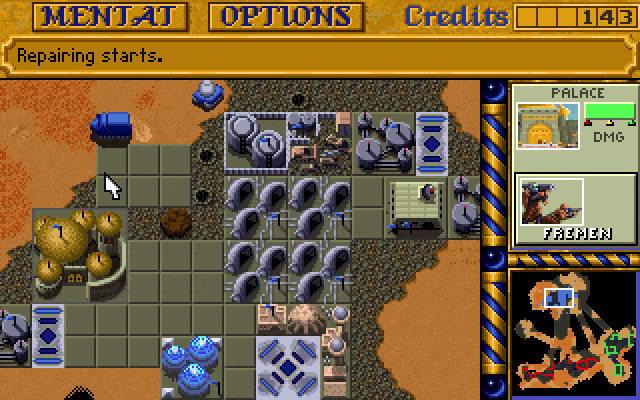
From that storied beginning, we have seen games as diverse as Halo Wars 2, Star Wars: Empire at War, Command and Conquer 3, and Dawn of War 2 contain one form of support power or another. But of course, this doesn't really set about to answer the real question: why? Why do RTS need these singular, powerful, game-altering abilities that one player can just inflict on their opponents?
It's a fair question, and I think it's one that has has several good answers.
First and foremost, support powers are often designed to be game enders and balance-tippers. By that, I mean they're supposed to give the player the upper hand.
To be even more clear: in games which feature support powers or super weapons, such tools are supposed to be difficult to get, but if they come out they're usually quite important to have the match resolve in a reasonable amount of time. Westwood's games in particular can reach stalemates in longer and more passive games thanks to powerful defensive options, relatively cheap structures (which can be sold off to recoup their cost and to have that cost be repurposed elsewhere) and fast-building units.
Universe at War is one example of how important it can be to have support powers to help definitively tip a game towards one player or the other. Thanks to the overall design of that game it's really hard to land a killing blow, especially into the later game. Hierarchy players can march around the map with their powerful late game walkers supported by large armies. The Novus can rebuild their armies at the drop of a hat and rebuild their buildings almost as fast, and the Masari have powerful bases designed to be incredibly tough nuts to crack.
Even with hero units and support powers, UAW matches can easily devolve into 40+ minute long stalemates with little hope of resolving before someone runs out of resources. A well-placed Black Hole from the Novus, or Hierarchy Radiation Cascade or Mass Drop can be just enough of a lever to crack someone's advantages and end the game.
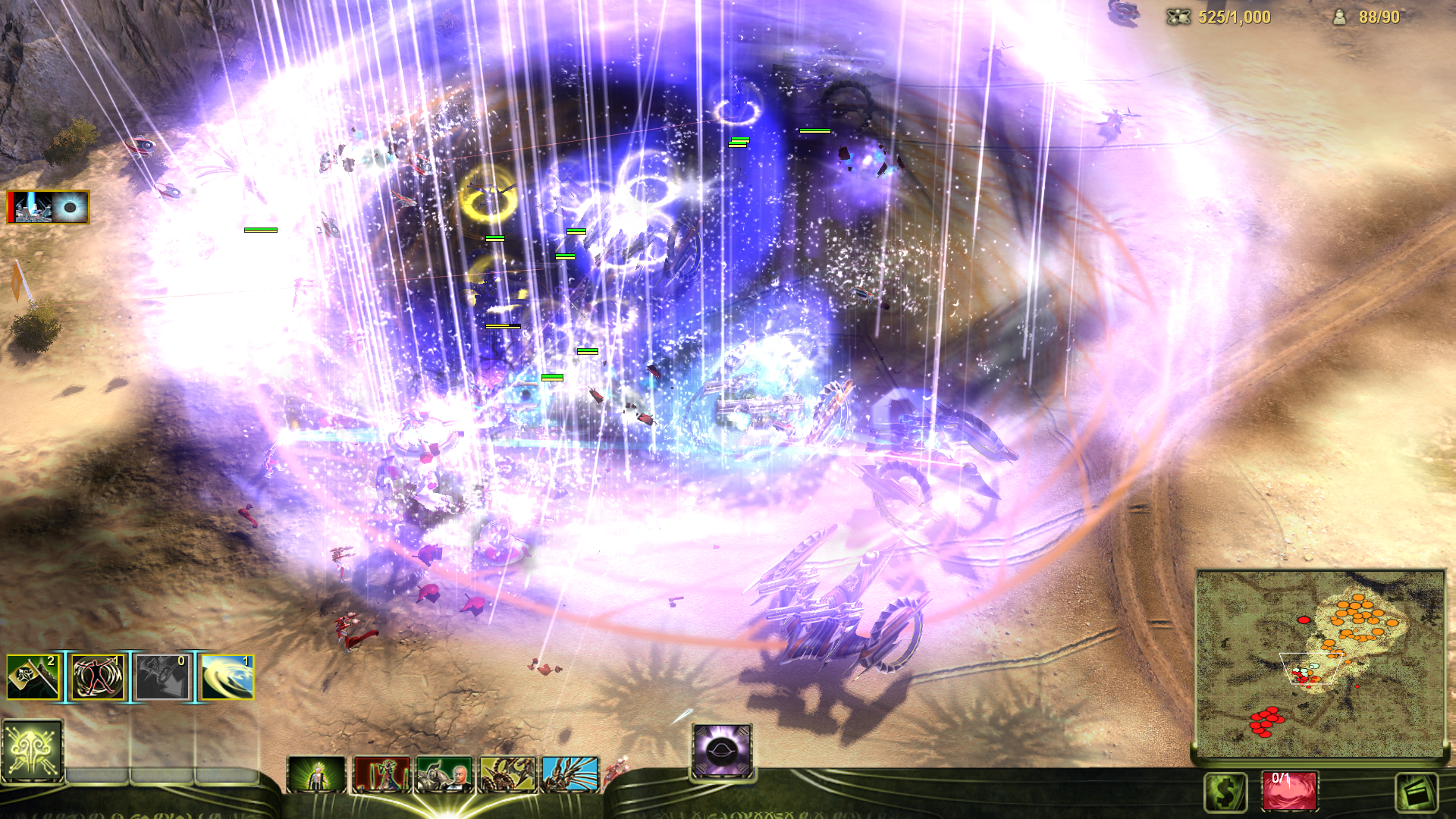
As I'm sure you can tell, I really appreciate how Universe at War handles both its design more generally and support powers specifically. But it's not the best example to use since it was never widely played. So, what reasons have other games included support powers?
Company of Heroes 2 and Dawn of War 2 are 2 other games which include support powers, and their systems are somewhat similar (there are some important differences too of course). Both COH2 and DOW2 tie their support power usage to combat performance and a custom resource: Dawn of War's "Red" resource is only usable on support powers, while in Company of Heroes 2, any support powers the player has access to are spent using the game's Munitions resource, which is also spent on unit abilities such as grenades.
Dawn of War 2 has what I would classify as traditional support powers: building summons, AOE damage abilities, unit healing (and reinforcement, important in Relic's games), buffs, debuffs, and more. Like in Universe at War, it's possible for Dawn of War matches to kind of stalemate, given the inexhaustible nature of resources and relatively large health pools of lategame combat options.
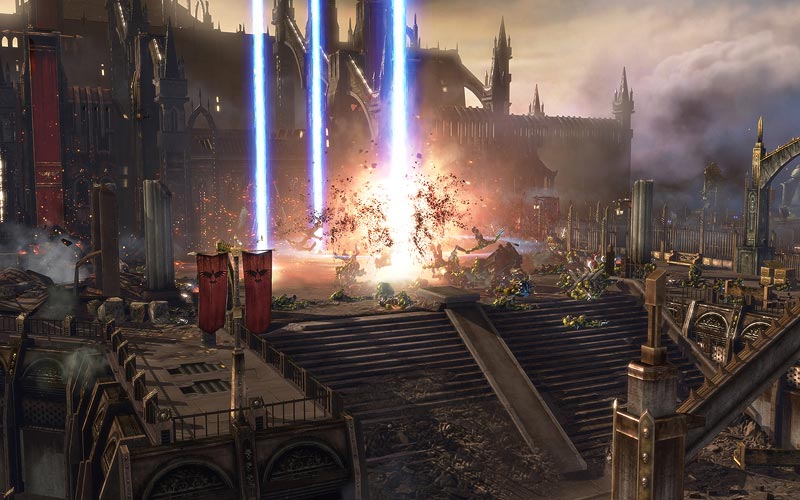
Honestly, and I say this as someone who supports (ha!) support powers generally, I think largely Dawn of War 2 doesn't need as much in the way of support powers as it has. They can be important for armies like the Tyranids to hold a field presence.
Anyways, we've clearly demonstrated that balance tipping is one of the key features of support powers in many games.
Superweapons like the Weather Control Center in RA2 serve a different purpose. It's a big deal when one comes online: the structure's location is often revealed to the other player, and a large countdown appears for all players, letting everyone know when the big boom is going to happen. And this, of course, provides pressure for one player to act. They've got limited time to make something happen before they take the big nasty hit.

Now of course, superweapons and support powers aren't the only ways to generate pressure and create balance tipping scenarios. But, importantly, support powers are one of the only aspects of RTS games that are truly transient - they last a moment and they're gone. Many unit abilities work this way as well: Psionic Storm has a duration of just a handful of seconds, after all.
However, when as in Command and Conquer: Kane's Wrath, or in Dawn of War 2, or in Company of Heroes, these transient effects come part and parcel with the permanent expenditure of player resources: they cost money, even if it's not from the same pool of cash the player uses to build structures and train units.
Additionally, with a unit that has an ability, the unit still has utility even if it's out of mana or its ability has a cooldown. Even if that utility is just taking a couple of shots instead of another unit, there's some sort of potential and permanence there. With a Kane's Wrath support power, or one from COH2 or DOW2, that money is gone if the ability is whiffed, and I think that adds something to these abilities. More risk, for one thing. If 1000, 1500, or 2000 resources of support power misses, it's gone forever. If a cooldown based power is whiffed, it's just a handful of minutes at most from being available again.
Of course the specific impact depends on the parameters of the power being used. Which begs the question of defining how these abilities are classified. So, of course, that's where I'm going next: categorizing support powers.
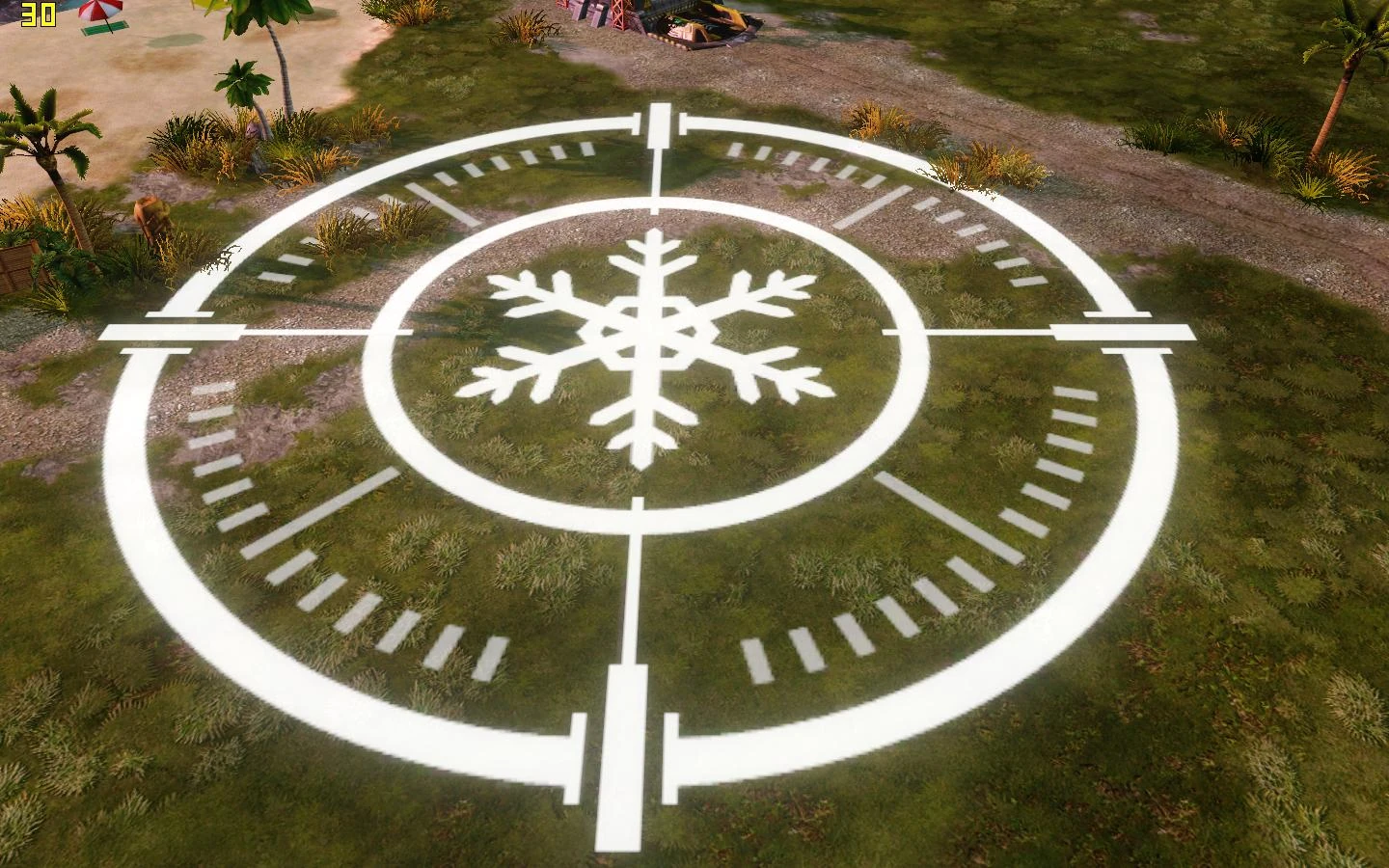
Kane's Wrath and Red Alert 3 have some of my personal favorite implementation of support powers and also serve as an illuminating case for comparing and contrasting the various approaches to how these abilities can be handled. For example: Red Alert 3's Support Powers are available so long as a player has 1 or more ConYards, and are earned via points gained by fighting opponents. They are also free to use but on a cooldown.
Contrasting with this, in Command and Conquer 3, Support Powers are unlocked in ones and twos with the construction of different structures, and are only available when that particular structure is present and powered. Additionally, and importantly, each Support Power costs money to use. These two approaches have a number of implications that are keenly felt when each game is played.
In Red Alert 3, support powers are more easily spammed, and if one doesn't hit (as is often the case with the earlier implementations of Cryoshot) it's typically not really a big deal for the casting player. But a support power whiff in C&C3:KW is a nigh catastrophic deal. Even a partial miss with a phase field, stasis shield, or EMP can really ruin the caster's day.

Halo Wars 2 is another example, and to me at least it shows the importance of cost and stat balancing for support powers. Halo Wars 2's powers are incredibly strong and game-changing, and to top it off are not as bad to miss with, making these abilities a relatively common and quite powerful option.
The list below represents what I see as the most common categories of support power, with a handful of examples provided for each. It should be noted that none of these categories are mutually exclusive and many games fall into more than one. For instance, many structure controlled support powers are also cooldown based, even if some cost resources and some are free after their unlocking building has been constructed.
'Structure controlled' support powers are a relatively common take on the implementation of these abilities, especially if we're figuring super weapons into the equation. Going back to Dune 2 and the original Command and Conquer, including every C&C game except for Red Alert 3, and Universe at War. Buildings are an easy way to handle a player's access to support option.
Killing the building, turning off a player's power (if that mechanic exists in the game), striking during the ability's countdown: these are all ways to handle this most accessible of support power options. There's clear counter play around the presence and status of the building that allows both players to have some say in when the weapons are able to fire.

Halo wars 2, Dawn of War 2, and Red Alert 3 are prime examples of this type of support power. Red Alert 3 might straddle the difference between "structure controlled" and "interface controlled" since an MCV or ConYard are required for the player to have access to their support powers, I suppose.
With this variant, it's a lot harder to control when the hits are coming for the player on the receiving end of these abilities. There's nothing (really) to do to stop the aggressor besides perhaps cost controls (or in RA3's case, killing the ConYard, which you want to do anyway)
To me, this method is less optimal than structure controlled, mostly due to the lack of any meaningful counter-play options involving when these abilities can be used. Especially in the case of Halo Wars 2, where end tier powers in particular are able to simply crush an enemy's army outright.
Switching tracks a bit, let's talk about how these abilities are priced in-game. My favorite method is when support powers are purchased via the game's primary resource. The 2 games I can think of off the top of my head that use this method are Kane's Wrath and Halo Wars 2, where support powers cost one or both of the game's main resources.

Now, to me, Halo Wars 2 kind of undervalues its support powers a bit to the point where they seem fairly spammable, but Kane's Wrath for all that some abilities might be overly costly for their value (they rarely see use on the competitive ladder) strike me as one of the better balanced implementations of support powers in the RTS space.
The Command and Conquer games have a unique relationship with support powers and super weapons though. In these games, everything is high impact. A single Shadow Strike Team, or Engineer in an APC, or Black Hand squad in an APC, a handful of Vertigos or a Flame Tank in the right time and the right place, can already take apart a base or wreck a critical piece of infrastructure at a critical juncture. In this context, an EMP or Orca Strike or Stasis Shield is just kind of the same thing scaled up to army size. Something like the Ion Cannon or Rift is a bit more of a game-ender, but the cost of those abilities scales proportionally.
Dawn of War 2 and Company of Heroes 2 are great examples of situations where support powers cost custom resources. I mentioned it above so I won't go through it all again here.
In Company of Heroes 2 in the early to mid game, it's pretty hard to save up enough resources to be able to drop a support power and still have munitions left over for grenades and things. And with Dawn of War 2, the 'red' resource generates so slowly that it's really uncommon to be able to spam support powers anyway. In these cases, to me, having the power cost a unique resource is a relatively effective solution, especially if the resource is one that is spent often.
Which actually, is probably the perfect time to bring up Ashes of the Singularity

Quanta is perhaps my favorite thing about the game Ashes of the Singularity: Escalation. It's a gated, scarce resource in a game otherwise about relatively disgusting displays of wealth and production. And importantly, Quanta has a lot of stuff going on with it. Spending Quanta is how a player unlocks a higher population cap, and is likewise the source of weapon and armor upgrades for units. And lastly, it's how Support Powers are purchased.
So casting an ability means that the player needs to wait longer to train up a larger army, and to put a delay on increasing their units' damage output. It's a wonderful balance system with some great implications to it, and it really makes the player feel the cost of calling on their support powers.
And, Ashes of the Singularity has something that almost no other game with support powers has, something that I think is a huge missing component from most games with this sort of ability: actual counter play in the form of support power jamming. We'll be talking about that next, after we finish out this section.

Powers which are purely cooldown driven, as with Red Alert 3, tend to be able to be spammed more easily and with less downsides than those that cost some resource. As soon as the ability is off cooldown, and a chance to fire that ability presents itself, it's going to be used. There's some opportunity cost to choosing a sub-optimal target or missing a shot, but otherwise there's no gating or stopping or forcing a player to think about the when and where and why of firing off any and every power at their disposal.
I suppose I just appreciate the greater commitment that comes from each shot of the power being something that's got a cost to it, to counterbalance the power's potential effect in the game.
And speaking of counterbalancing support powers...
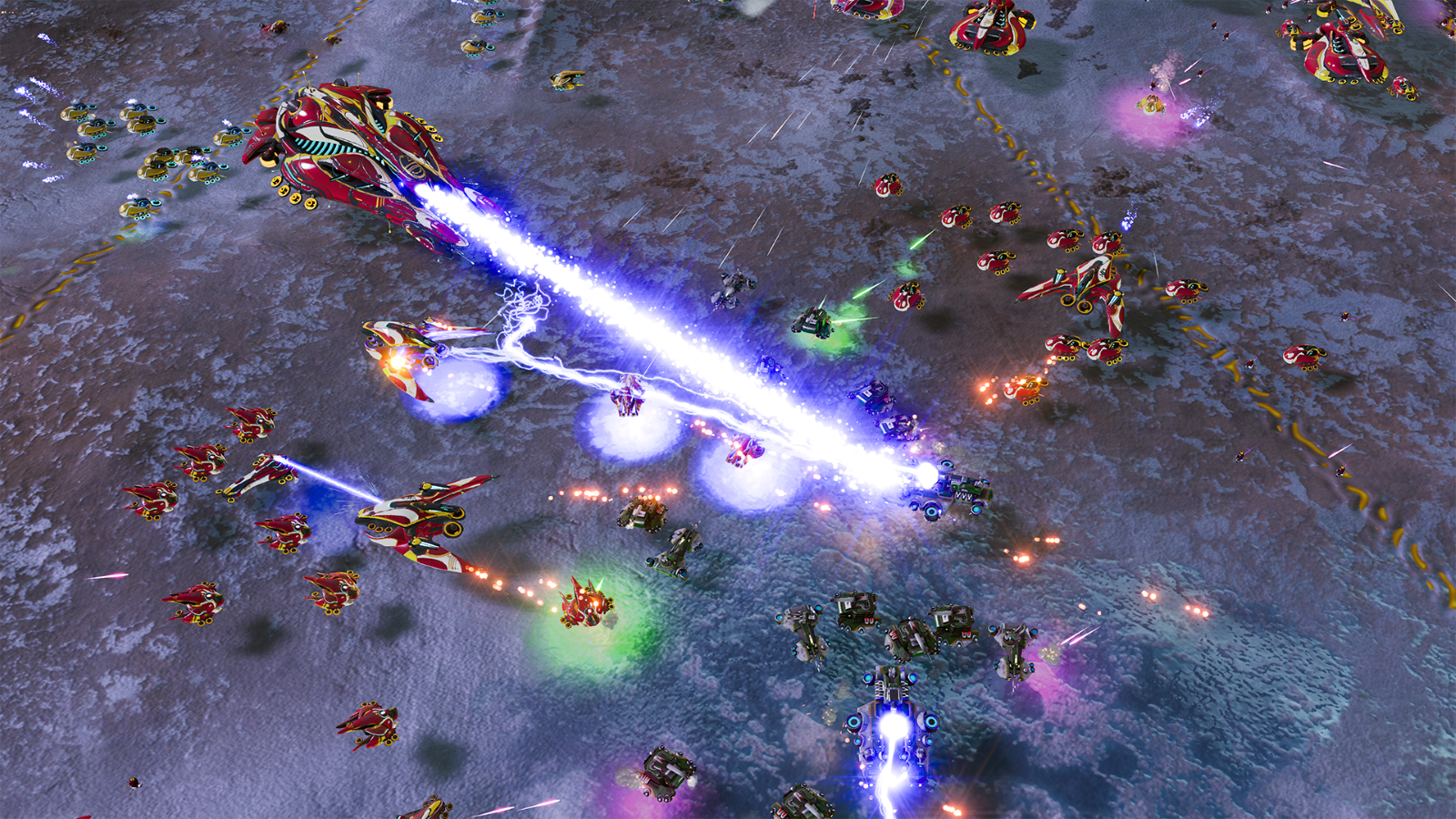
To me, the biggest problem surrounding support powers is the way they interact with the rest of the game.
Most of the time, countering support powers basically amounts to "don't let them hit you" or "don't let the other player use them" - there's really no real counter play to these abilities most of the time. I don't think micro or stalling the launch of the ability really count as counter play in a meaningful sense.
Supreme Commander has several systems that protect against various weapons that are adjacent to support powers. In Supreme Commander and SupCom2, missiles and artillery provide players on the receiving end with the same sorts of feeling of frustrated powerlessness that is felt when hit with a superweapon in other RTS games, and so the SupCom franchise has built in systems that can provide some relief and counter play opportunities to these weapons.​

To defend against nuclear warheads, players may build T2 or T3 (pictured above) missile defense systems. These systems must be loaded manually with counter-nukes and are fairly expensive, but protect against the powerful strikes to a reasonable degree in a reasonable radius. This allows players on the sending and receiving end of nuclear missiles (or weaker tactical missiles at T2) to have control over whether the missiles hit their target. And for the sending player, it's a matter of killing the defense structure or preventing the missiles from being built, so a layered "I can do this, but you can do that, but I can do this other thing etc" is built up around missiles instead of a more flat "I've got a missile, you're out of luck" sort of scenario that would be more reflective of how support powers work in most games.
Ashes of the Singularity also has a system that provides players a way to actually actively prevent the enemy from dropping a bomb (as it were) where the player doesn't want it dropped. One of the support powers available to each faction prevents the summoning of enemy powers in its area for a fixed duration. It's more a proactive thing than a reactive thing, since it's only really usable before the orbital strike is used, but it's a far sight better than nothing. Players, as in SupCom, may also build orbital shields to more permanently defend areas from being subjected to these sorts of abilities.

I think such counter play systems need to be a lot more common in RTS games. They allow for the presence of game-ending powers while still giving both players the ability to control when and whether such things can happen to them. An additional layer of defense from orbitals and support powers and super weapons (whatever you want to call them) just serves to add depth and interest to these systems - the main potential downside is that, coupled with base defenses, the use of orbitals and support powers is cut down dramatically. But with balanced cost, area of effect, and something like SupCom's ammo for these potent defenders, it's more than possible to create dynamic systems of counter play that add considerably to the interest of games which choose to include these abilities and weapons.
And I think it could go a lot farther too. Spells like instants and enchantments in games like Magic the Gathering are functionally similar to support powers in that they're mostly transient and function differently to units in meaningful ways. Protection, mitigation, and dispelling are all perfectly valid counter systems to support powers that again would only serve to add depth and interest to such systems.
There's a huge possibility space that hasn't been adequately explored around counter play for support powers and super weapons. The Scrin's stasis and phase abilities can serve as snap defenses to being hit by 1 clicks, as a for-instance: temporary force fields, building teleportation... there's a vast opportunity to create a complex layered economy of interactions around powerful abilities like these.
One thing I neglected to mention about why I prefer (in some sense) support powers and super weapons over unit abilities in some cases is that these powers are player level tools. To clarify: in RTS games, functionality that's locked away behind selecting a unit can feel alienating and distances the player from the immediate ability to change and interact with the game on their terms.
Many times, unit abilities feel appropriate coming from a unit. That Conscript squad is throwing its own grenade. That engineer is laying down mines one at a time. But the player, the commander, the cerebrate, the general... It feels good to give them direct options too, a way to react to the game happening around them in direct and meaningful ways.
Selling off buildings and depowering buildings in C&C games is a similar thing. In those games, the player has control over changing their mind and altering the impact of their decisions in meaningful ways, empowering the player to more directly interact with the game beyond channeling their will through masses of units that might not do exactly what is needed exactly when it's needed.
To me, support powers have the potential to be a powerful source of depth and interaction and empowerment for players. And there's some simple ways that RTS designers can increase and improve the depth and dynamism of support powers.
Thanks for reading. I hope to see you on the battlefield.
(Read this at its original location on my game design blog)
Read more about:
Featured BlogsYou May Also Like